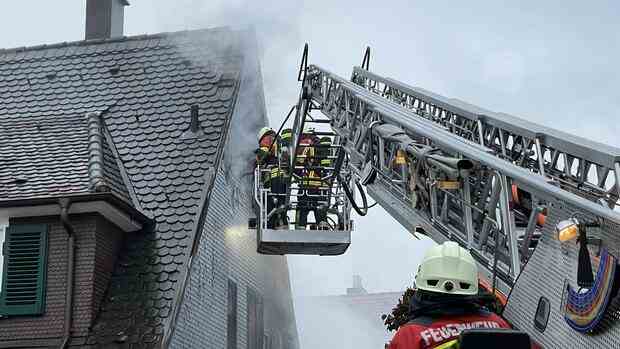Insurance coverage will be significantly more expensive in 2023.
(Photo: imago images/7aktuell)
Frankfurt Consumers have to be prepared for significant premium increases in residential building insurance. Brokers report premium increases of up to 30 percent at the top. One reason is the massive increase in construction costs.
For policyholders, it initially seems incomprehensible why the premium is rising significantly faster than the inflation of ten percent in Germany recently. However, this is because most residential buildings are insured at sliding replacement value.
This means: In order for the sum insured to be sufficient to cover a total loss of the building, for example after a fire, the value of the insured house must be regularly adjusted to the current costs for a comparable new building. More decisive than the general inflation development is how much the construction price index for residential buildings and the collective wage index for the construction industry have risen.
In addition to the sum insured, residential building insurers must also increase the premium – in accordance with the so-called adjustment factor, which is calculated from the indices mentioned. According to the insurance association GDV, this adjustment factor has increased by around three percent per year over the past ten years. For 2023, however, it will jump by almost 15 percent compared to the previous year.
Top jobs of the day
Find the best jobs now and
be notified by email.
Some homeowners insurers strictly adhere to this increase rate; there will be no further increases in contributions from them. These include Axa, SV Versicherung and Helvetia, as they told the Handelsblatt.
Many residential buildings are insured at the variable replacement value.
(Photo: dpa)
The Signal Iduna also refrained from further adjustments due to the “strained financial situation of many people”. However, annual premium increases of three percent based on the age of the building have been contractually agreed for young buildings. This tariff feature applies regardless of price and claims development. Allianz, on the other hand, does not want to comment on changes in contributions.
Residential building division is in deficit across the industry
There can be various reasons why some insurers are increasing their premiums even more. The older unrenovated residential buildings are, the more often damage occurs. Storm damage is also increasing as a result of climate change.
The Gothaer Allgemeine reports, for example: “Depending on the contract constellation, selected tariffs are increased by up to 9.5 percent as required in addition to the adjustment factor.” The maximum is an increase of almost 25 percent. The VHV also says that an extraordinary premium adjustment will be carried out on December 1, 2022. For certain contracts, this could result in premium increases of over 15 percent.
The mixed situation is difficult – for consumers and insurers. The VHV points out that the residential building sector is in deficit across the industry. Especially in the wake of the flood in the Ahr Valley last year, some insurers had to settle claims of an unprecedented magnitude.
>> Read also: Gothaer wants to continue growing in 2023 despite the difficult environment – and is relying on medium-sized companies
As can be seen from recently published Bafin statistics, the gross loss ratios in residential building insurance for numerous providers were over 100 percent in 2021. Insurance premiums are often not sufficient to cover claims expenses. For Provincial Versicherung, for example, the key figure was 178.7 percent, for Huk-Coburg 139.6 percent, for Gothaer Allgemeine 135.2 percent and for R+V Allgemeine 131.5 percent.
2021 was the most expensive natural hazard year for German insurers.
(Photo: dpa)
However, insurers should be careful not to prematurely terminate homeowners insurance. It would be worse to end up with no insurance at all. Nevertheless, it is worth comparing the providers. Studies by the consumer magazine “Finanztest” show again and again that policies with very good performance can have price differences of several hundred euros per year.
More: Compulsory insurance against natural hazards – the government sees no rejection
